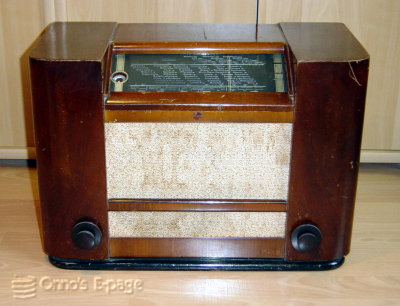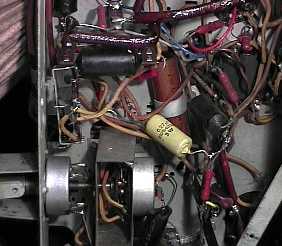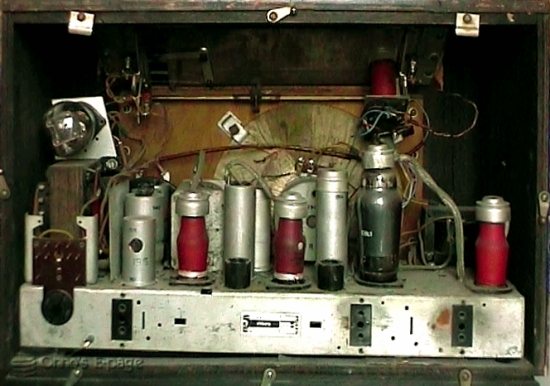Until shortly, this was the oldest radio that I had.
The tubes used have the typical Philips 'side contact' (P-type) base.
- EK2 heptode as oscillator/mixer
- EF5 pentode as IF amplifier,
- EBC3 as detector and first AF stage
- EBL1 as output stage
- EM1 "cat's eye" tuning indicator
- AZ1 power rectifier.
It has a slanted tuning dial. Like many of the radios of its age,
it has a triple tuning capacitor, two sections of which are used to
form a selective band filter at the input.
High selectivity is necessary because of the low IF (128 kHz),
to reject mirror frequencies.
I got this one in 1976 from a neighbour of a friend, who was throwing it
away.
I considered this a rare old radio so I decided to keep it as a piece
of antique.
I did have some spare parts, taken from a chassis in bad condition of a
similar old radio I had taken apart.
First I had to replace the wiring to the tuning indicator (EM1).
Then it turned out that the output stage had a low-frequency oscillation
and that there was no further sound. Cleaning the band switch and
replacing the output tube remedied this.
I also replaced a number of capacitors, as you can see.
After that, the radio worked again, and that's what I
wanted.
Some years later, it started to squeak and cause whistling noises
in other radios nearby. It turned out that if I touched the EF5,
this is the IF amplifier, the whistle sometime disappeared. Because
the tube was not cemented to its base very tightly, I supposed that
the connection to the internal shield was broken. Because I
couldn't get an EF5 anywhere, I replaced it with an EF6,
which I thought was an equivalent.
After that, the radio played reasonably well.
In summer 2000 I wanted to listen to it again
but its sound was very distorted, especially on strong stations.
When I opened the radio I suddenly wondered why all the smaller
tubes had been painted red.
Instead of going on with the repair, I posted a question on the
Dutch old radio forum
if anybody knew why these tubes were painted red.
Several people told me this was conductive paint and that its
purpose was to act as a shield.
This was exactly what I needed to know to fix the old EF5!
I used some conductive paint from the car parts shop
(for repairing rear window defogging heaters)
and the shield was ok again.
Putting back the old EF5 cured the distortion.
EF5 is a variable-mu penthode, used as a controllable amplifier.
EF6 isn't, so with an EF6 the MF amplifier amplifies too much
and cuts off when the AVC cuts in. Fine recipy for distortion.
Now the radio plays well again.
As one can see on this older photograph, something was wrong with this radio.
In 1977, during a removal, I dropped something on it and the dial
glass was broken.
I repaired the cracks using transparent silicone rubber and reinforced the
glass plate using metal strips, but the cracks remained visible.
For a few years I have been looking for a replacement dial without
much success.
But in early summer 2005, two damaged 667A's came my way.
One had exactly the right dial, so I could finally replace the dial.
It was not really what I had hoped, because the lettering was slightly faded.
At that occasion, I was also able to replace the PVC wiring to the
tuning indicator with old rubber insulated wires from one of the wrecks.
The second wreck had a dial in very good condition, but it was a slightly
different type of dial.
I was able to combine the two radios to (re)build
a second 667A, that looks really pretty.






